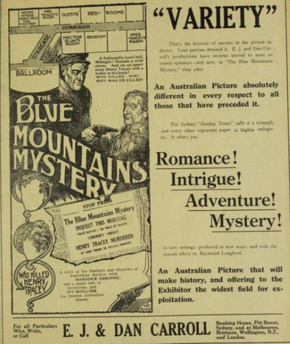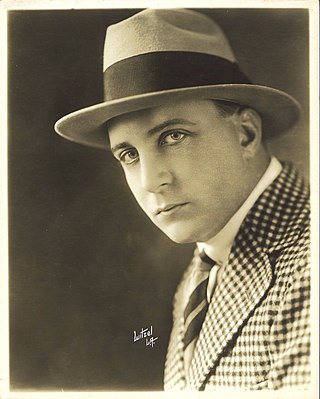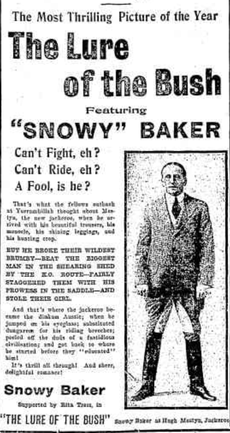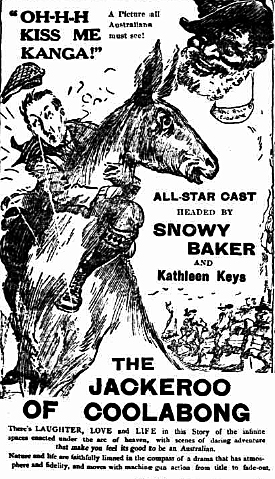
Charles Edward Chauvel OBE was an Australian filmmaker, producer and screenwriter and nephew of Australian army General Sir Harry Chauvel. He is noted for writing and directing the films Forty Thousand Horsemen in 1940 and Jedda in 1955. His wife, Elsa Chauvel, was a frequent collaborator on his filmmaking projects.

Reginald Leslie "Snowy" Baker was an Australian athlete, sports promoter, and actor. Born in Surry Hills, an inner-city suburb of Sydney, New South Wales, Baker excelled at a number of sports, winning New South Wales swimming and boxing championships while still a teenager. Playing rugby union for Eastern Suburbs, he played several games for New South Wales against Queensland, and in 1904 represented Australia in two Test matches against Great Britain. At the 1908 London Olympics, Baker represented Australasia in swimming and diving, as well as taking part in the middleweight boxing event, in which he won a silver medal. He also excelled in horsemanship, water polo, running, rowing and cricket. However, "His stature as an athlete depends largely upon the enormous range rather than the outstanding excellence of his activities; it was as an entrepreneur-showman, publicist and businessman that he seems in retrospect to have been most important."

The Man from Snowy River is a 1920 film made in Australia. The film was silent and filmed in black and white, and was based on the Banjo Paterson poem of the same name. It is considered a lost film.

Agnes Vernon was an American film actress of the silent era. While still in her teens, she experienced a meteoric ascent from obscurity to box-office sensation. After turning twenty-three and a movie career fading away, she abandoned the silver screen forever. Vernon performed in over 90 films between 1913 and 1922. She completed most of her roles under contract with Universal Pictures.

Bernice Vere was an English-born stage, playwright, director, and film actress. She emigrated to Australia when she turned 12. She started performing on stage in Australia until the movie-producing team of E.J. Carroll and Snowy Baker discovered her. They cast her in the silent feature The Shadow of Lightning Ridge, where she acted alongside American actress Agnes Vernon.

The Blue Mountains Mystery is a lost 1921 Australian silent film directed by Raymond Longford and co-directed by Lottie Lyell.

Arthur Shirley was an Australian actor, writer, producer, and director of theatre and film. He experienced some success as a film actor in Hollywood between 1914 and 1920.
Frank Beaumont "Beau" Smith, was an Australian film director, producer and exhibitor, best known for making low-budget comedies.
The Mutiny of the Bounty is a 1916 Australian-New Zealand silent film directed by Raymond Longford about the mutiny aboard HMS Bounty. It is the first known cinematic dramatisation of this story and is considered a lost film.

The Enemy Within is a 1918 Australian silent film starring renowned Australian sportsman Snowy Baker in his first screen role.

The Lure of the Bush is a 1918 Australian silent film starring renowned Australian sportsman Snowy Baker. It is considered a lost film.

The Man from Kangaroo is a 1920 Australian silent film starring renowned Australian sportsman Snowy Baker. It was the first of several films he made with the husband and wife team of director Wilfred Lucas and writer Bess Meredyth, both of whom had been imported from Hollywood by E. J. Carroll.

The Jackeroo of Coolabong is a 1920 Australian silent film starring renowned Australian sportsman Snowy Baker. It was the last of three films he made with the husband and wife team of director Wilfred Lucas and writer Bess Meredyth, both of whom had been imported from Hollywood.
Within Our Gates, also known as Deeds that Won Gallipoli, is a 1915 Australian silent film about Australia's fight with the German Empire and the Ottoman Empire during World War I, including the landing at Gaba Tepe during the Gallipoli campaign. The story was partly based on a play The Man Who Stayed at Home.
Edward John Carroll, better known as E. J. Carroll, was an Australian theatre and film entrepreneur. He produced several films of Snowy Baker and Raymond Longford and helped establish Birch, Carroll and Coyle. Difficulties in securing international distribution for his films turned him away from production towards exhibition.
Jonas Alfred Lipman, frequently referred to as "Joe", was an Australian philanthropist, actor, producer and director of theatre and film. He was described as "a colourful extrovert" with "a flair for the wheeling and dealing of the film trade".
Southern Cross Feature Film Company was a short lived film production company that made some of Australia's most famous silent films, mostly directed by Raymond Longford. One of the key figures behind it was Sir David Gordon.

John K. Wells was an American actor, director, producer, and writer of the Silent film era. Wells was a 29-year old actor who earned his first credited role in the 1915 Universal short film — The Queen of Hearts.
The Bushranger is a 1928 American silent Western film directed by Chester Withey and written by George C. Hull, Paul Perez, and Madeleine Ruthven. Set in Australia, the film stars Tim McCoy, Ena Gregory, Russell Simpson, Arthur Lubin and Ed Brady.
Sir Herbert William Gepp was an Australian industrial chemist, businessman and public servant.












